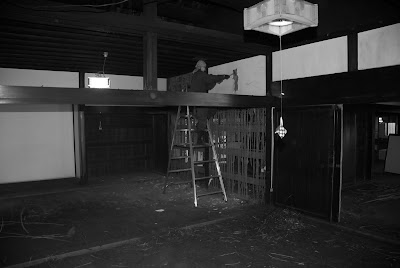
A little over a month ago, or less than a week before the earthquake it was a beautiful afternoon so we drove out to the other side of Fuji to spend an interesting Sunday afternoon in a traditional Japanese restaurant Kominka.
My wife & Keiko had spent the previous afternoon there, talking with the elderly but very energetic owner - who'd been keen to share his experiences with renewing an old building. He'd restored this little old house in mostly traditional style, with some charming results.



We had a traditional Oodong noodle lunch and as the restaurant closed he came to sit with us and talk. The conversation led into traditional Japanese life and what he remembered as a child, which I couldn't help but find fascinating:
He described life during shortages of food & fuel, etc. In those days in this very village that was now pretty much deserted life had thrived. Small open houses built close to one another had been common in the village and each family knew it's neighbours intimately.
The father would be home from work early to eat with his family and they'd all go to bed at the same time, sleeping in the same room with futons lined next to one another. Because everybody lived so close, people had to be considerate of their neighbour as well as those in his family. The community spirit was strong. People would share their produce from the food they grew & they were humble, but it was a proper way to live. Marriage was usually arranged by the parents to someone they thought the best for their son or daughter. This kind of Japanese lifestyle existed for hundreds of years and it's not hard to realise this history was the cause of Japanese people's ingrained humility, considerate attitude and honesty in general today, especially amongst people in their 70's or even older.
He talked about today's young Japanese generations, who to him seem to have lost much of that tradition. Most young people choose to move to the larger cities for work and end up being in a much lonlier place as a result. Neighbours are replaced with talk shows on TV and people rarely if ever interact when out and about in city roads. Their best chance of meeting friends is through work.
It's as if what we call progress is actually going backwards as people are more stressed, less happy and in modern society often feel loneliness and a lack of sense of purpose. I couldn't help but agree that consideration of others we live near as part of a community is a lot healthier than caring primarily for oneself. Are today's modernised ways really progress?
Here's an interesting video of why today's two parent working families are much more likely to fail. Although it compares what families did in the 1970's to now, it seems traditional ways had better answers to cope with inevitable difficulties than modern society & dare I say it, western influences: The coming collapse of the middle class.
In the last few weeks I was remembering what he'd said whilst observing so much change in Japan from tsunami & earthquake damage with Fukushima now a main priority to get completely under control.
After the 2nd world war there was no food in Japan, so people then made it by working within communities thereby making a unified country to rebuild whilst sacrificing what they had to. Their collective efforts & resultant strength made Japan become truly great within a short space of time as a result. These ancestors knew life’s not about helping ourselves first & foremost – it's about grace to one another. Influence by example can be the greatest way of effecting change.
Watching & reading about progress in the North of Japan, I've been encouraged to notice these values remain within the Japanese from hundreds of years of Japanese civilisation. It was heartening to see it so evident in the face of life changing losses. In these food & fuel shortages there were no squabbles or fighting when supplies were short, even the worst hit areas in the North. Instead people have found kindness with food left on their doorsteps overnight from neighbours & help in rebuilding and picking themselves up. Many have helped one another despite enduring unimaginable grief & losses themselves. Who can but admire such attitude.
Compare with what happened in Japan when there were shortages to the States with Katrina or what would happen in the UK given similar circumstances of no supply & desperate people.
–
In difficult times we can expect the Japanese to remain humble, helpful and self-disciplined, not riot, fight and climb over one another to be first. It’s response like this that the news should be reporting on and showing examples of, not scaremongering in order to sell news. If anything this low quality of reporting shows the state of today's media. Although it's meant to be there to inform us of the truth it doesn't always show an unbiassed opinion.





















